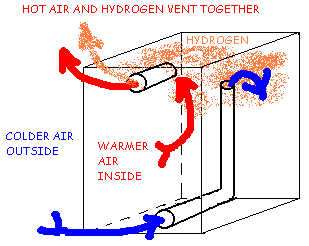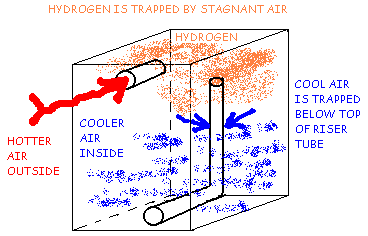HYDROGEN VENTILATION USING HIGH VENT AND LOW VENT WITH RISER TUBE
A battery enclosure using a high vent and a riser tube is shown in Figure 4A & 4B. This type of ventilation system also attempts to use the properties of natural convection as described in Example 2. The use of a riser tube helps to prevent some of the unwanted thermal convection described in Example 2 which can cause too much air flow and excessive temperature extremes inside the box.
Figure 4A
Hydrogen Ventilation Using High Vent and Low Vents with Riser Tube, Cold Day.

Figure 4A shows that on a cool day, the lighter warm air and lighter Hydrogen will rise together to the top of the box and exit from the high vent. This will happen only if there is a wide enough temperature difference between the warm and cold air to draw heavier cool air up the riser tube, into the box.
Figure 4B
Hydrogen Ventilation Using High Vent and Low Vents with Riser Tube, Warm Day.
Figure 4B shows that on a warm day, when the inside temperature is cooler than outside, air flow through the vents will stagnate, allowing hydrogen to collect at the top of the box. Warm air trys to rise into the top vent, blocking the hydrogen from coming out. The Hydrogen is too light to sink down the riser tube, and most of the cool air in the box is trapped below the top of the riser tube preventing any significant reverse airflow. When these stagnation conditions occur in conjunction with a battery charger in thermal runaway, explosive levels are likely to build up inside the box.

